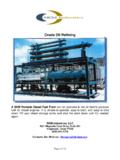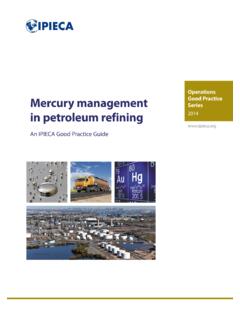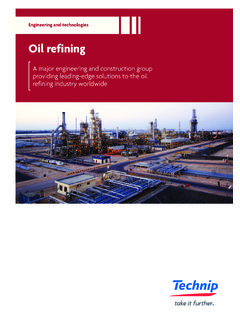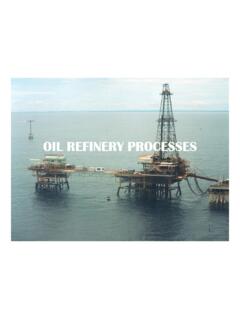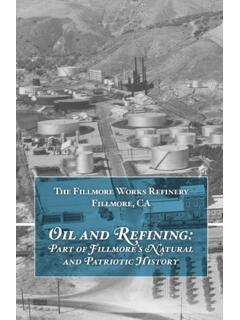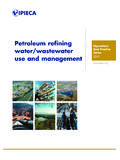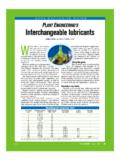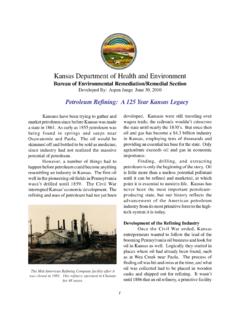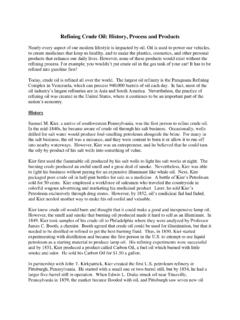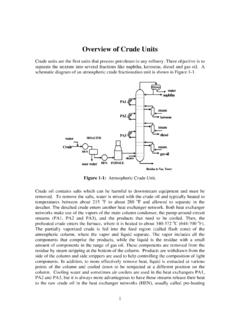Transcription of AVAILABLE AND EMERGING TECHNOLOGIES FOR REDUCING ...
1 I Office of Air and Radiation October 2010 AVAILABLE AND EMERGING TECHNOLOGIES FOR REDUCING greenhouse GAS EMISSIONS FROM THE PETROLEUM refining INDUSTRY ii AVAILABLE and EMERGING TECHNOLOGIES for REDUCING greenhouse Gas Emissions from the Petroleum refining Industry Prepared by the Sector Policies and Programs Division Office of Air Quality Planning and Standards Environmental Protection Agency Research Triangle Park, North Carolina 27711 October 2010 iii Table of Contents Introduction .. 1 Petroleum refining .. 1 Overview of Petroleum refining Industry .. 1 Petroleum refining GHG Emission Sources.
2 3 Stationary Combustion Sources .. 5 Flares .. 6 Catalytic Cracking Units .. 6 Coking Units .. 7 Catalytic Reforming Units .. 8 Sulfur Recovery Vents .. 9 Hydrogen Plants .. 9 Asphalt Blowing Stills .. 9 Storage 10 Coke Calcining Units .. 10 Other Ancillary Sources .. 10 Summary of GHG Reduction Measures .. 11 Energy Programs and Management Systems .. 16 Sector-Specific Plant Performance Benchmarks .. 19 Industry Energy Efficiency Initiatives .. 19 Energy Efficiency Improvements in Facility Operations .. 19 Monitoring and Process Control Systems .. 19 High Efficiency Motors .. 20 Variable Speed Drives .. 21 Optimization of Compressed Air Systems.
3 21 Lighting System Efficiency Improvements .. 21 GHG Reduction Measures by Source .. 22 Stationary Combustion Sources .. 22 Steam Generating Boilers .. 22 Process Heaters .. 24 Combined Heat and Power (CHP) .. 24 Carbon Capture .. 25 Fuel Gas Systems and Flares .. 26 Fuel Gas Systems .. 26 Flares .. 27 Cracking Units .. 28 Catalytic Cracking Units .. 28 Hydrocracking Units .. 29 Coking Units .. 29 Fluid Coking Units .. 29 Flexicoking Units .. 30 Delayed Coking Units .. 30 Catalytic Reforming Units .. 31 Sulfur Recovery Units .. 31 iv Hydrogen Production Units .. 31 Combustion Air and Feed/Steam Preheat .. 32 Cogeneration.
4 32 Hydrogen Purification .. 32 Hydrotreating Units .. 32 Crude Desalting and Distillation Units .. 33 Desalter Design .. 33 Progressive Distillation 33 Storage Tanks .. 34 Vapor Recovery or Control for Unstabilized Crude Oil Tanks .. 34 Heated Storage Tank Insulation .. 35 References .. 35 EPA 38 List of Figures Figure 1. Simplified flowchart of refining processes and product flows. Adapted from Gary and Handwerk (1994).. 2 Figure 2. Contribution of different emission sources to the nationwide CO2 equivalent GHG emissions from petroleum refineries.. 3 Figure 3. Contribution of different GHG to the nationwide CO2 equivalent GHG emissions from petroleum refineries.
5 4 Figure 4. Direct CO2 emissions from fuel consumption and indirect CO2 emissions electricity and steam purchases at petroleum refineries from 2003 to 5 Figure 5. ENERGY STAR Guidelines for Energy Management .. 18 Figure 6. Process schematic of a progressive distillation process (from ARCADIS, 2008).. 34 List of Tables Table 1. Summary of GHG Reduction Measures for the Petroleum refining Industry .. 11 1 Introduction This document is one of several white papers that summarize readily AVAILABLE information on control techniques and measures to mitigate greenhouse gas (GHG) emissions from specific industrial sectors. These white papers are solely intended to provide basic information on GHG control TECHNOLOGIES and reduction measures in order to assist States and local air pollution control agencies, tribal authorities, and regulated entities in implementing TECHNOLOGIES or measures to reduce GHGs under the Clean Air Act, particularly in permitting under the prevention of significant deterioration (PSD) program and the assessment of best AVAILABLE control technology (BACT).
6 These white papers do not set policy, standards or otherwise establish any binding requirements; such requirements are contained in the applicable EPA regulations and approved state implementation plans. This document provides information on control techniques and measures that are AVAILABLE to mitigate greenhouse gas (GHG) emissions from the petroleum refining industry at this time. Because the primary GHG emitted by the petroleum refining industry are carbon dioxide (CO2) and methane (CH4), the control TECHNOLOGIES and measures presented here focus on these pollutants. While a large number of AVAILABLE TECHNOLOGIES are discussed here, this paper does not necessarily represent all potentially AVAILABLE TECHNOLOGIES or measures that that may be considered for any given source for the purposes of REDUCING its GHG emissions.
7 For example, controls that are applied to other industrial source categories with exhaust streams similar to the petroleum refining industry may be AVAILABLE through technology transfer or new TECHNOLOGIES may be developed for use in this sector. The information presented in this document does not represent EPA endorsement of any particular control strategy. As such, it should not be construed as EPA approval of a particular control technology or measure, or of the emissions reductions that could be achieved by a particular unit or source under review. Petroleum refining Overview of Petroleum refining Industry Petroleum refineries produce liquefied petroleum gases (LPG), motor gasoline, jet fuels, kerosene, distillate fuel oils, residual fuel oils, lubricants, asphalt (bitumen), and other products through distillation of crude oil or through redistillation, cracking, or reforming of unfinished petroleum derivatives.
8 There are three basic types of refineries: topping refineries, hydroskimming refineries, and upgrading refineries (also referred to as conversion or complex refineries). Topping refineries have a crude distillation column and produce naphtha and other intermediate products, but not gasoline. There are only a few topping refineries in the , predominately in Alaska. Hydroskimming refineries have mild conversion units such as hydrotreating units and/or reforming units to produce finished gasoline products, but they do not upgrade heavier components of the crude oil that exit near the bottom of the crude distillation column. Some topping/hydroskimming refineries specialize in processing heavy crude oils to produce asphalt.
9 There are eight operating asphalt plants and approximately 20 other 2 hydroskimming refineries operating in the United States as of January 2006 (Energy Information Administration [EIA], 2006). The vast majority (approximately 75 to 80 percent) of the approximately 150 domestic refineries are upgrading/conversion refineries. Upgrading/conversion refineries have cracking or coking operations to convert long-chain, high molecular weight hydrocarbons ( heavy distillates ) into smaller hydrocarbons that can be used to produce gasoline product ( light distillates ) and other higher value products and petrochemical feedstocks. Figure 1 provides a simplified flow diagram of a typical refinery.
10 The flow of intermediates between the processes will vary by refinery, and depends on the structure of the refinery, type of crude processes, as well as product mix. The first process unit in nearly all refineries is the crude oil or atmospheric distillation unit (CDU). Different conversion processes are AVAILABLE using thermal or catalytic processes, , delayed coking, catalytic cracking, or catalytic reforming, to produce the desired mix of products from the crude oil. The products may be treated to upgrade the product quality ( , sulfur removal using a hydrotreater). Side processes that are used to condition inputs or produce hydrogen or by-products include crude conditioning ( , desalting), hydrogen production, power and steam production, and asphalt production.










